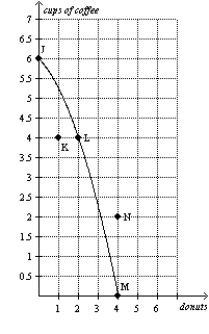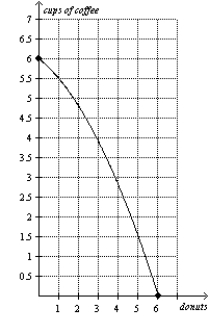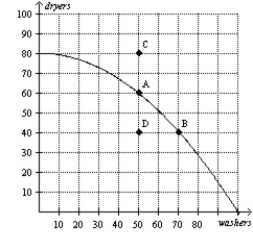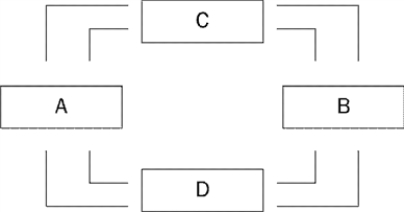A) upward sloping, and we say the variables are positively related.
B) upward sloping, and we say the variables are negatively related.
C) downward sloping, and we say the variables are positively related.
D) downward sloping, and we say the variables are negatively related.
F) A) and D)
Correct Answer

verified
Correct Answer
verified
Multiple Choice
The use of the coordinate system allows
A) for the display of the flows of dollars, goods and services, and factors of production in an economic system.
B) for the display of how labor and other resources are organized in the production process.
C) for the display of two variables on a single graph.
D) for the creation of pie charts and bar graphs.
F) B) and C)
Correct Answer

verified
Correct Answer
verified
Short Answer
In the markets for goods and services in the circular flow diagram, households act as
Correct Answer

verified
Correct Answer
verified
True/False
Changes in one variable on a graph might be caused by the other variable on the graph or by a third omitted variable.
B) False
Correct Answer

verified
Correct Answer
verified
Multiple Choice
Which of the following statements about models is correct?
A) The more details a model includes, the better the model.
B) Models assume away irrelevant details.
C) Models cannot be used to explain how the economy functions.
D) Models cannot be used to make predictions.
F) A) and D)
Correct Answer

verified
Correct Answer
verified
Multiple Choice
In the circular-flow diagram,
A) taxes flow from households to firms, and transfer payments flow from firms to households.
B) income payments flow from firms to households, and sales revenue flows from households to firms.
C) resources flow from firms to households, and goods and services flow from households to firms.
D) inputs and outputs flow in the same direction as the flow of dollars, from firms to households.
F) All of the above
Correct Answer

verified
Correct Answer
verified
Multiple Choice
Yi and Avik are both economists. Yi thinks that taxing consumption, rather than income, would result in higher household saving because income that is saved would not be taxed. Avik does not think that household saving would respond much to a change in the tax laws. In this example, Yi and Avik
A) hold different normative views about the tax system.
B) disagree about the validity of a positive theory.
C) have a fundamental misunderstanding of the tax system.
D) More than one of the above is correct.
F) B) and C)
Correct Answer

verified
Correct Answer
verified
Multiple Choice
Suppose an economy produces two goods, food and machines. This economy always operates on its production possibilities frontier. Last year, it produced 1000 units of food and 47 machines. This year, it is producing 1050 units of food and 52 machines. Which of the following events could not explain the increase in output?
A) a reduction in unemployment
B) an increase in available labor
C) an improvement in technology
D) Any of these events could explain the increase in output.
F) A) and D)
Correct Answer

verified
Correct Answer
verified
Multiple Choice
Figure 2-9
Panel (a)
Panel (b) 
 -Refer to Figure 2-9, Panel (a) . The movement from point M to point K could be caused by
-Refer to Figure 2-9, Panel (a) . The movement from point M to point K could be caused by
A) an advance in production technology.
B) an improvement in efficiency.
C) economic growth.
D) unemployment.
F) All of the above
Correct Answer

verified
Correct Answer
verified
Multiple Choice
Figure 2-5  -Refer to Figure 2-5. It is not possible for this economy to produce at point
-Refer to Figure 2-5. It is not possible for this economy to produce at point
A) A.
B) B.
C) C.
D) D.
F) A) and B)
Correct Answer

verified
Correct Answer
verified
True/False
Economists may disagree about the validity of alternative positive theories about how the world works.
B) False
Correct Answer

verified
Correct Answer
verified
Multiple Choice
Figure 2-2  -Refer to Figure 2-2. Boxes A and B of this circular-flow diagram represent
-Refer to Figure 2-2. Boxes A and B of this circular-flow diagram represent
A) firms and households.
B) households and government.
C) the markets for goods and services and the markets for financial assets.
D) the markets for goods and the markets for services.
F) C) and D)
Correct Answer

verified
Correct Answer
verified
True/False
In the ordered pair (10,30), 10 is the y-coordinate and 30 is the z-coordinate.
B) False
Correct Answer

verified
Correct Answer
verified
Multiple Choice
Which of the following is not held constant when looking at an individual's demand curve?
A) income
B) price
C) preferences
D) the availability of alternative goods
F) C) and D)
Correct Answer

verified
Correct Answer
verified
True/False
If an economy can produce more of one good without giving up any of another good, then the economy's current production point is inefficient.
B) False
Correct Answer

verified
Correct Answer
verified
True/False
Different values are not a reason for disagreement among economists.
B) False
Correct Answer

verified
Correct Answer
verified
True/False
When two variables move in the same direction, the curve relating them is downward sloping, and we say the variables are negatively related.
B) False
Correct Answer

verified
Correct Answer
verified
True/False
The effects of borrowing by the federal government would be studied by a microeconomist rather than a macroeconomist.
B) False
Correct Answer

verified
Correct Answer
verified
Multiple Choice
When an economist evaluates a positive statement, he or she is primarily
A) examining evidence.
B) acting as a scientist.
C) concerned with verifying how the world is.
D) All of the above are correct.
F) B) and C)
Correct Answer

verified
Correct Answer
verified
Multiple Choice
Suppose an economist advises a city's mayor to begin charging drivers a fee to drive on a busy highway during congested times. The mayor does not implement the policy because it would not be popular with voters. Which of the following statements best describes the scenario?
A) This is a common occurrence. The policymaker knows the best policy but chooses not to institute it for other reasons.
B) This is a common occurrence. The policymaker usually disregards an economist's advice because they do not believe it is the most efficient policy.
C) This is an unlikely occurrence. Most of the time, policymakers follow the advice of economists and institute the most efficient policies.
D) This would never happen. Policymakers always follow the advice of economists.
F) None of the above
Correct Answer

verified
Correct Answer
verified
Showing 461 - 480 of 643
Related Exams